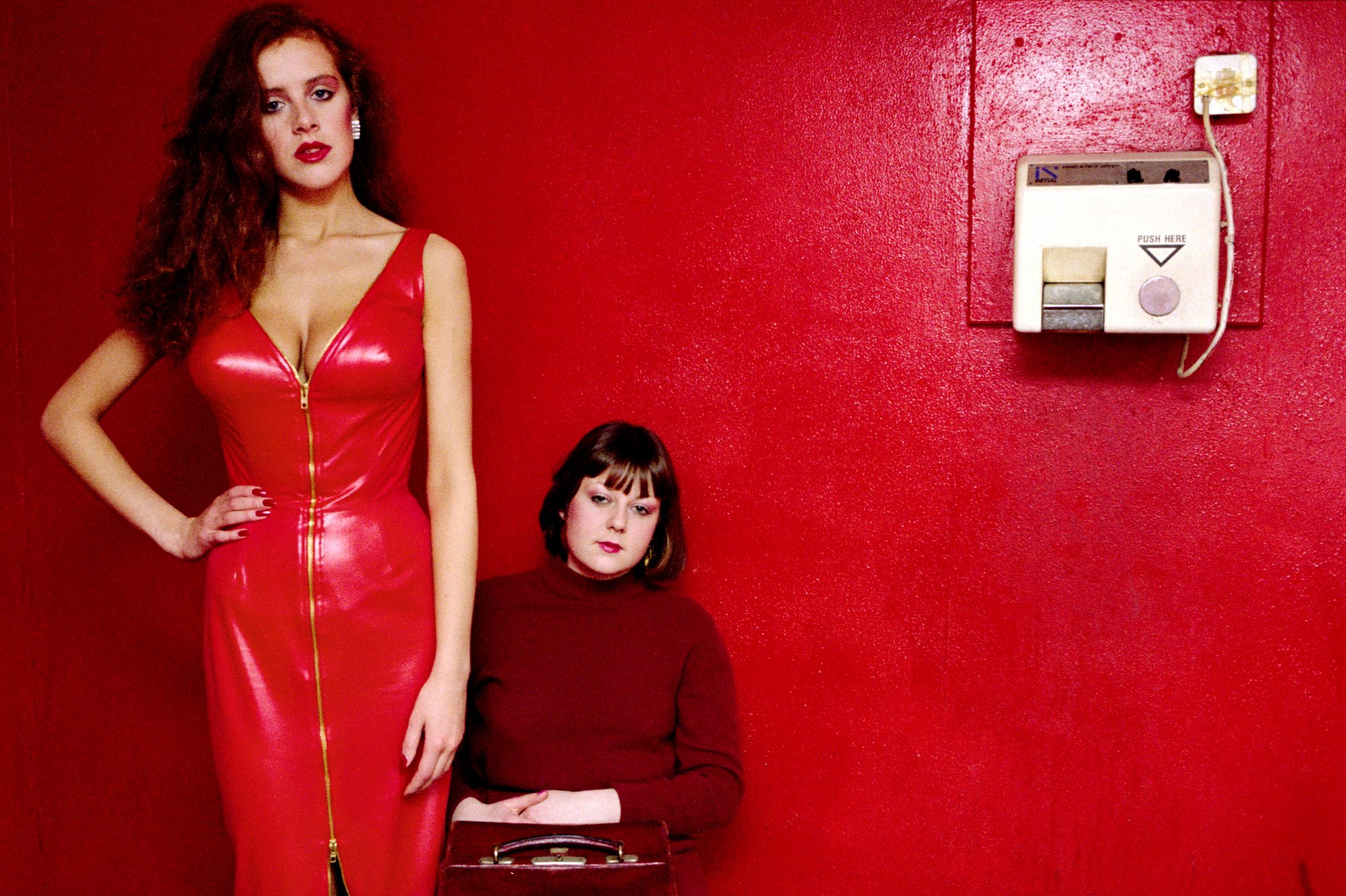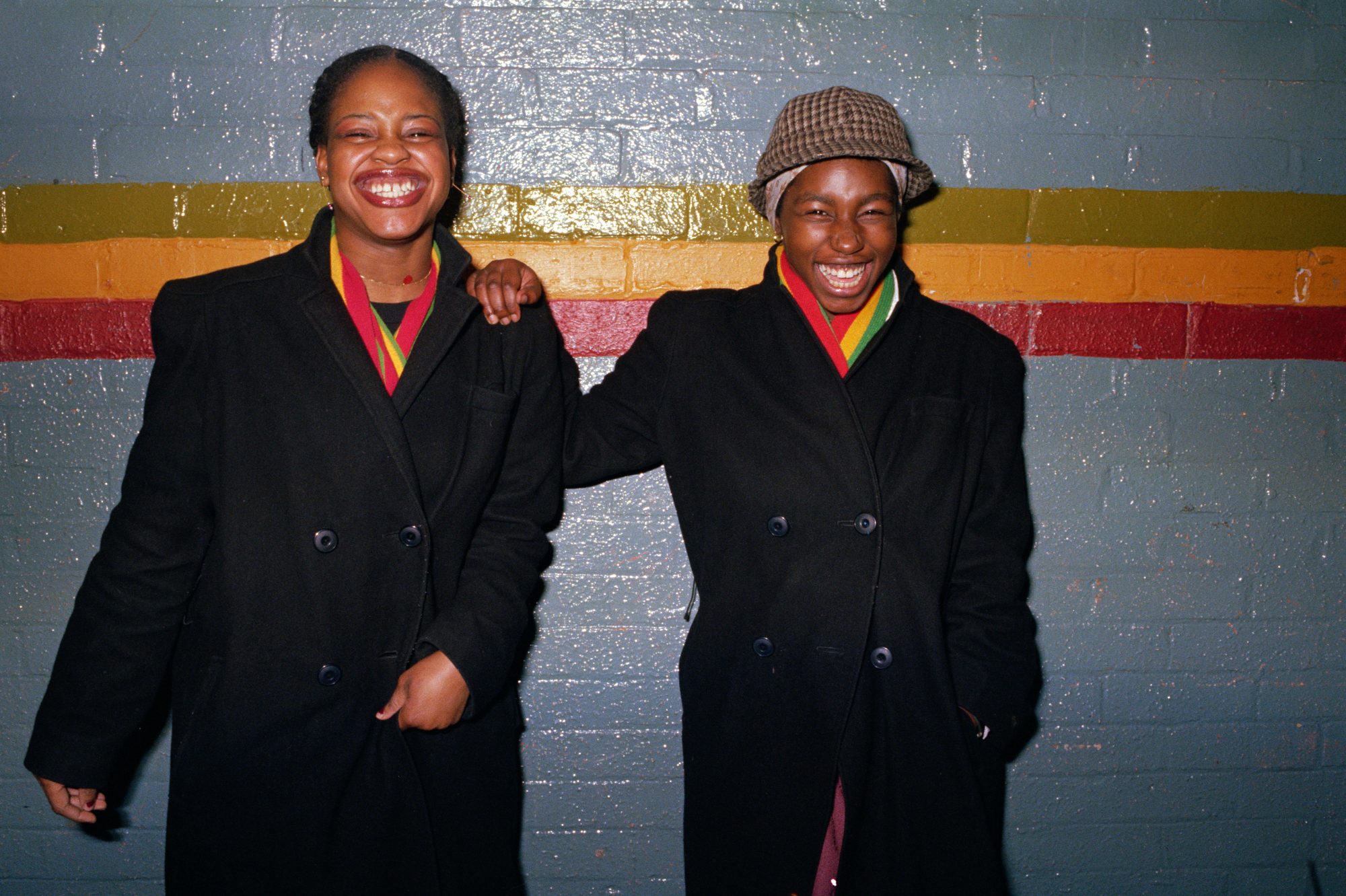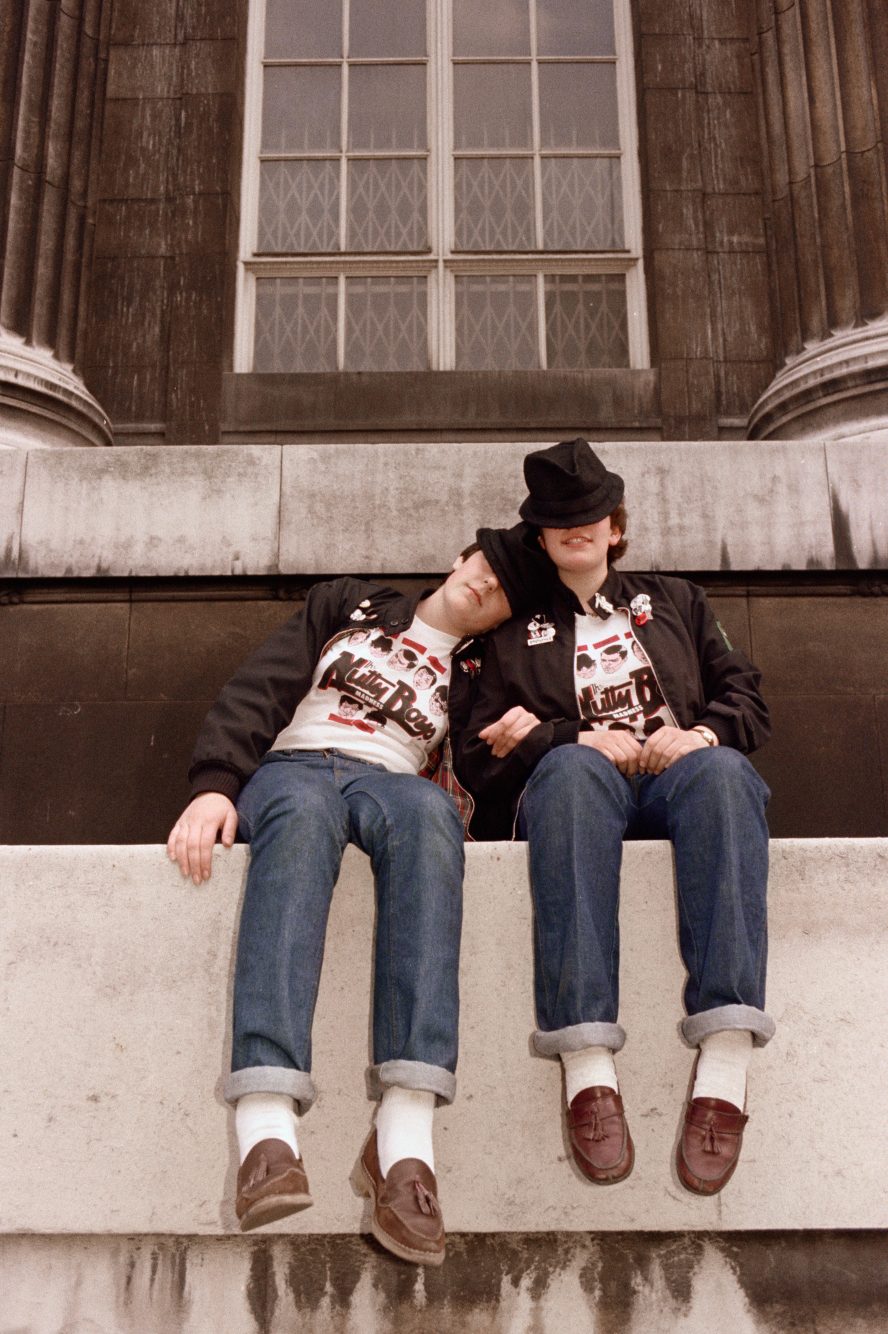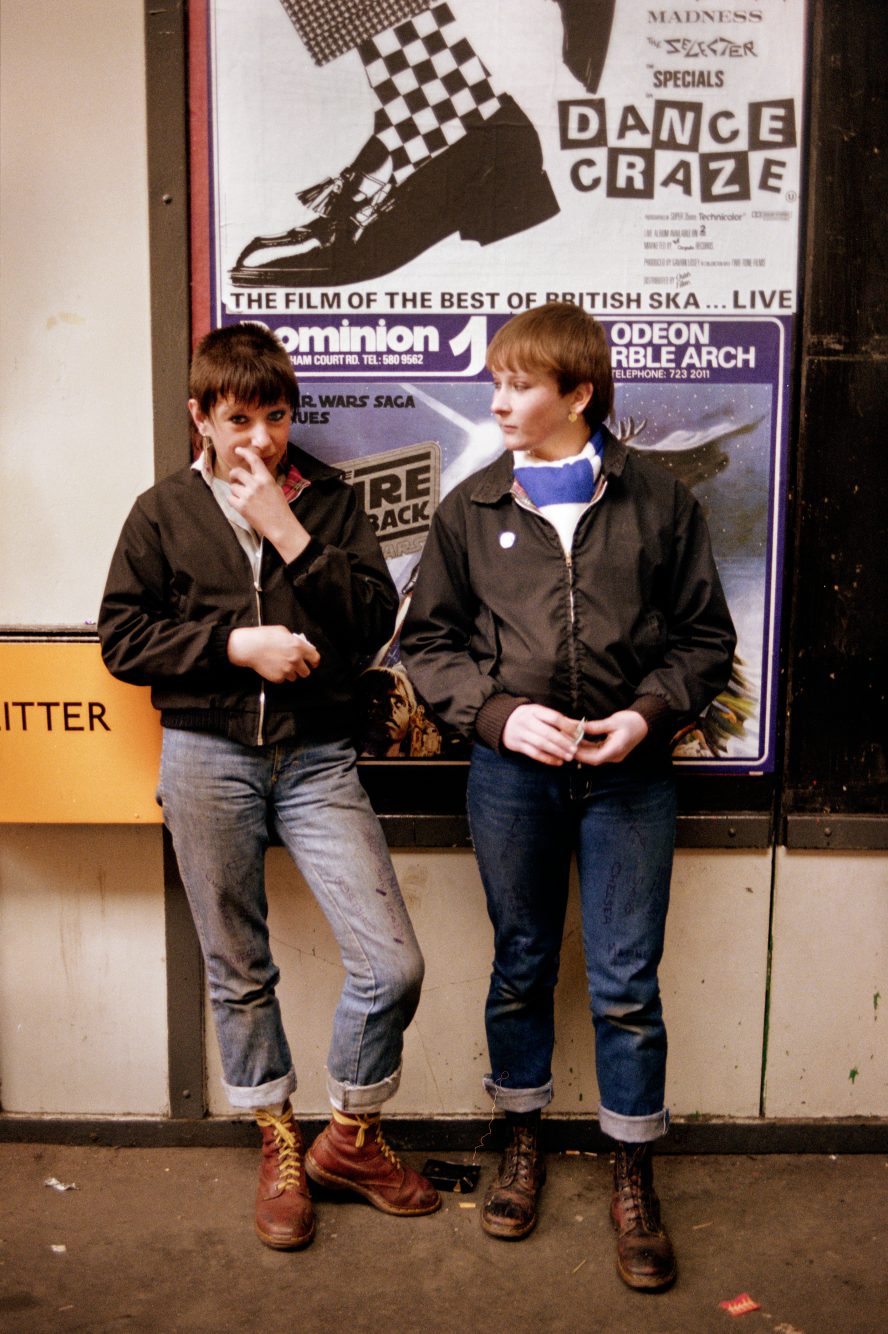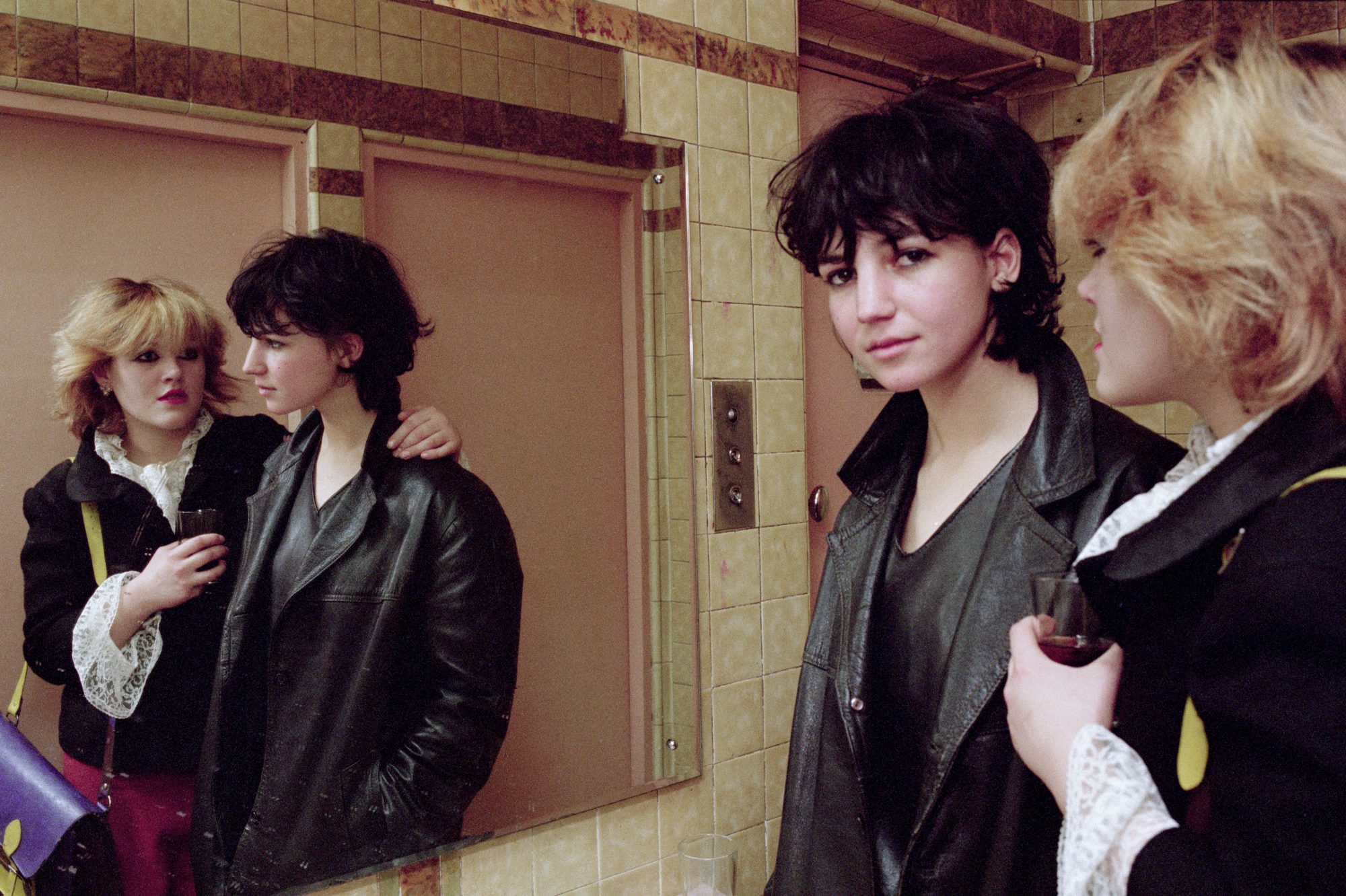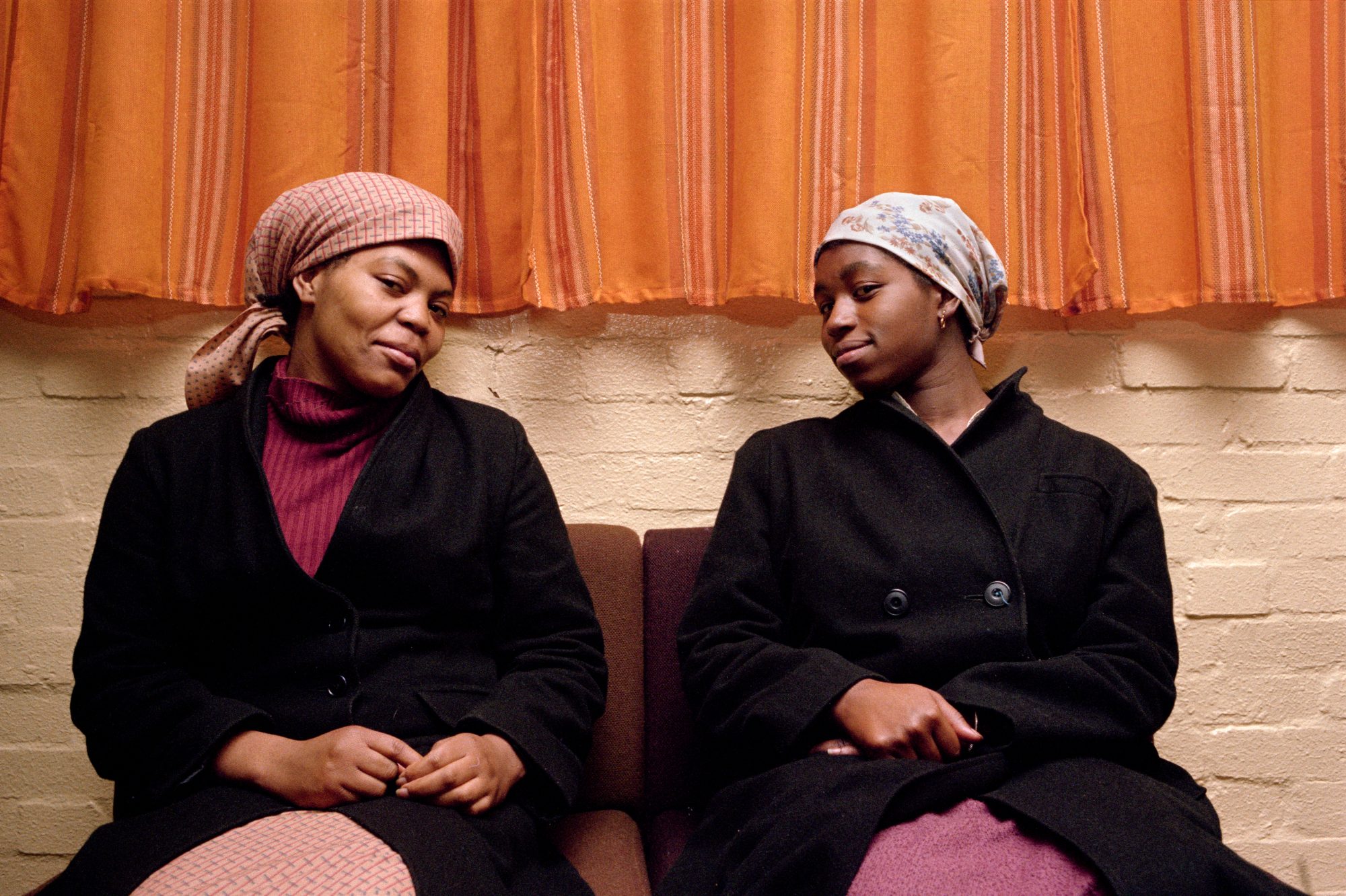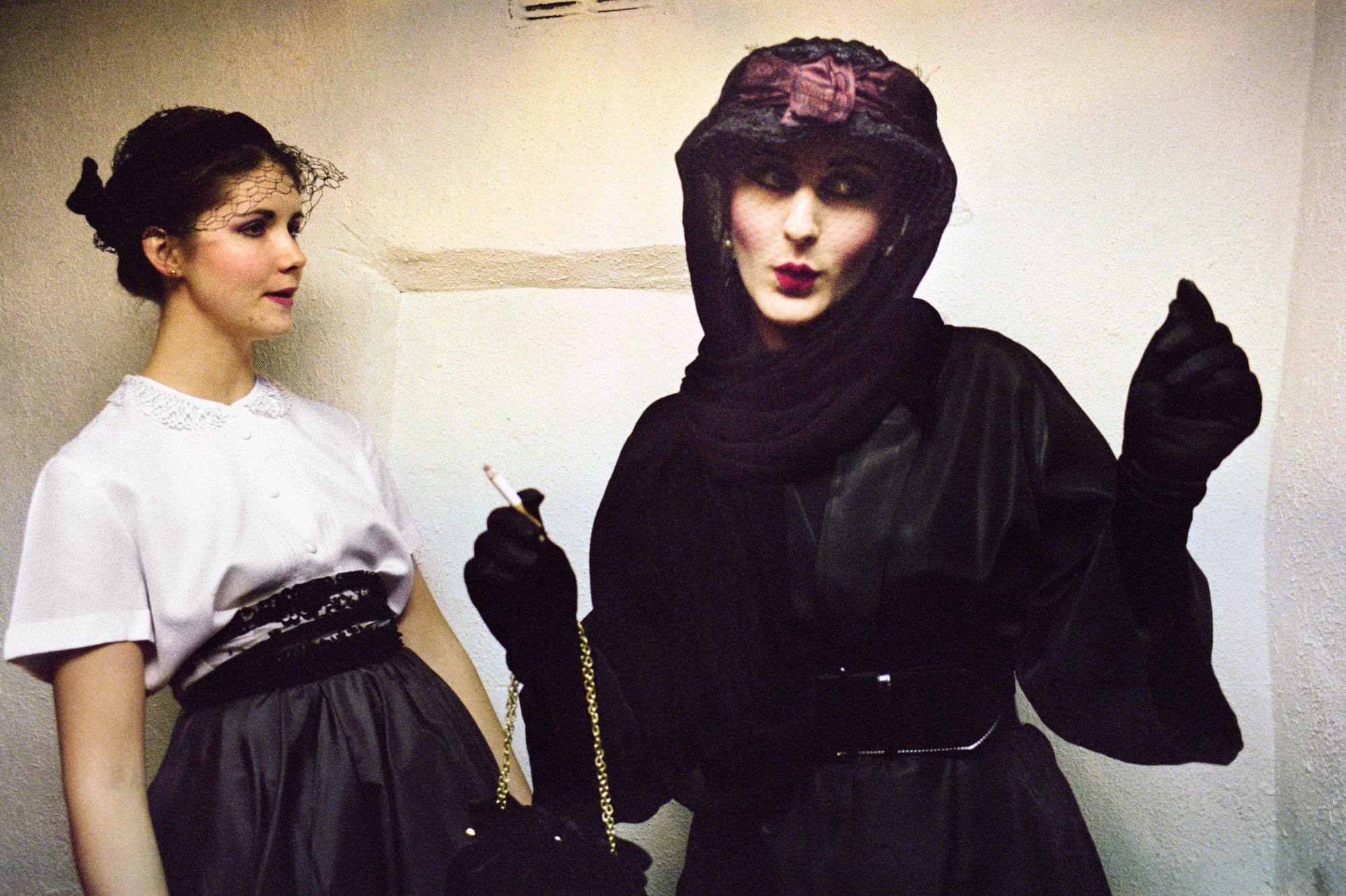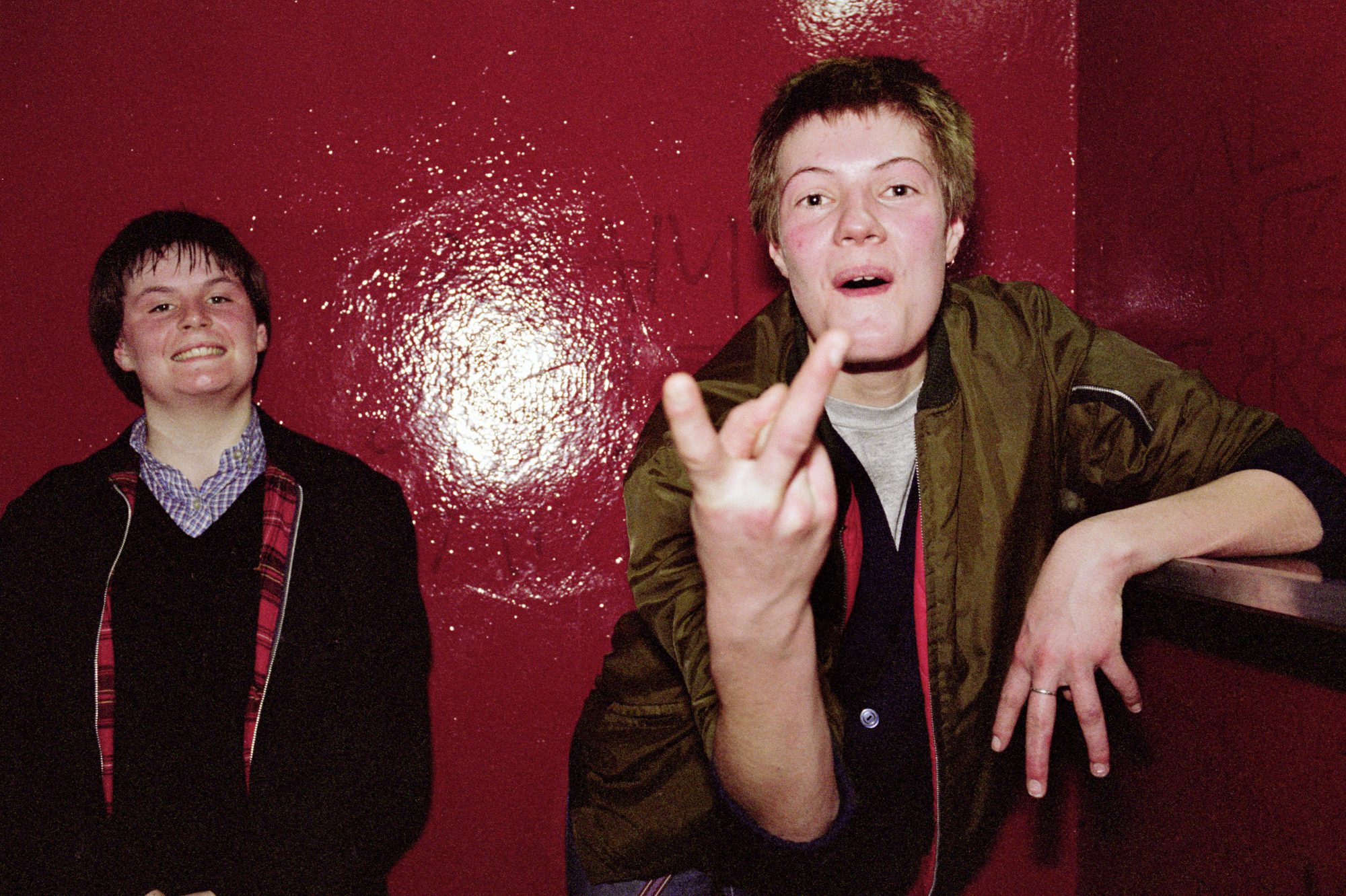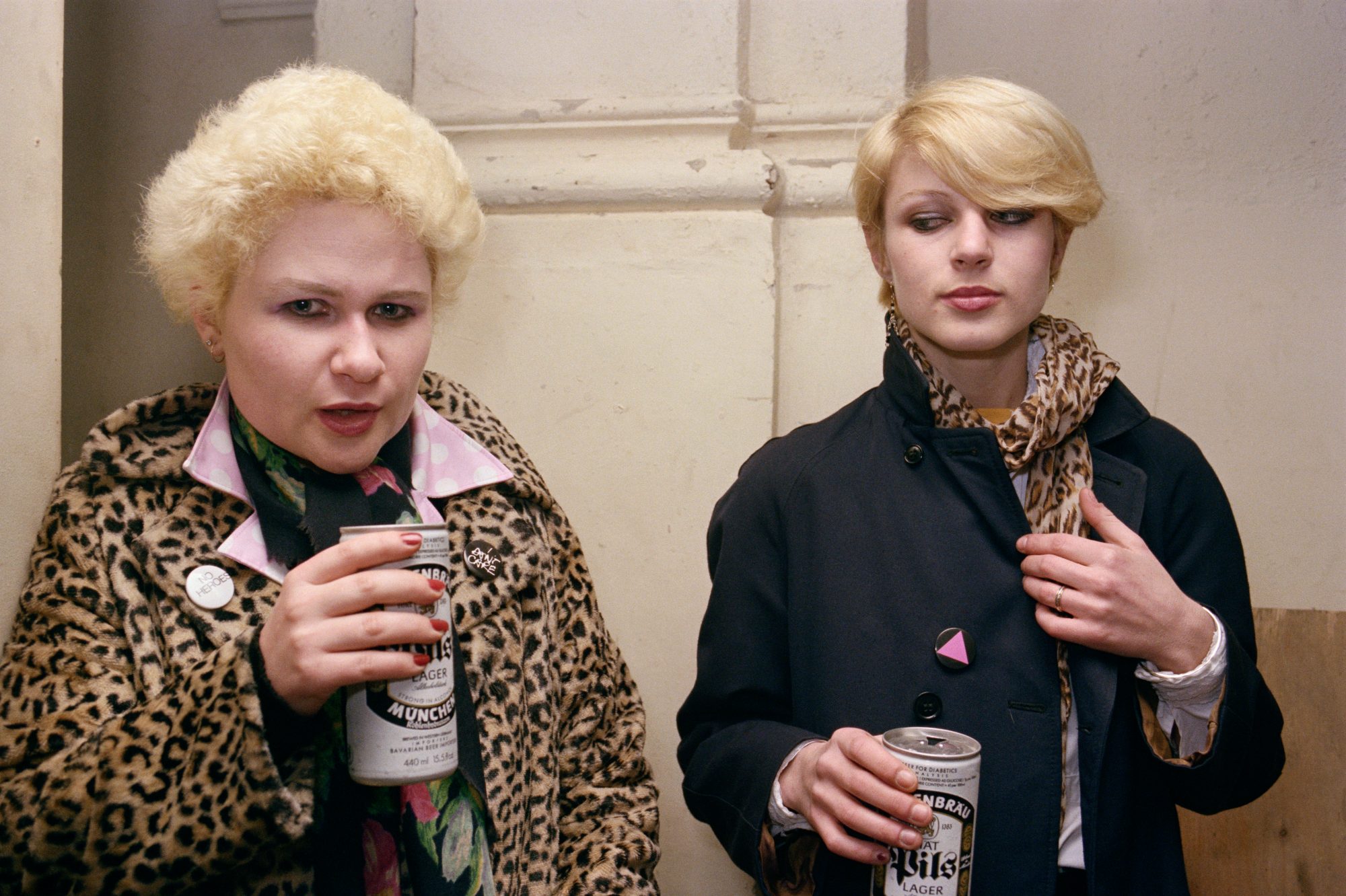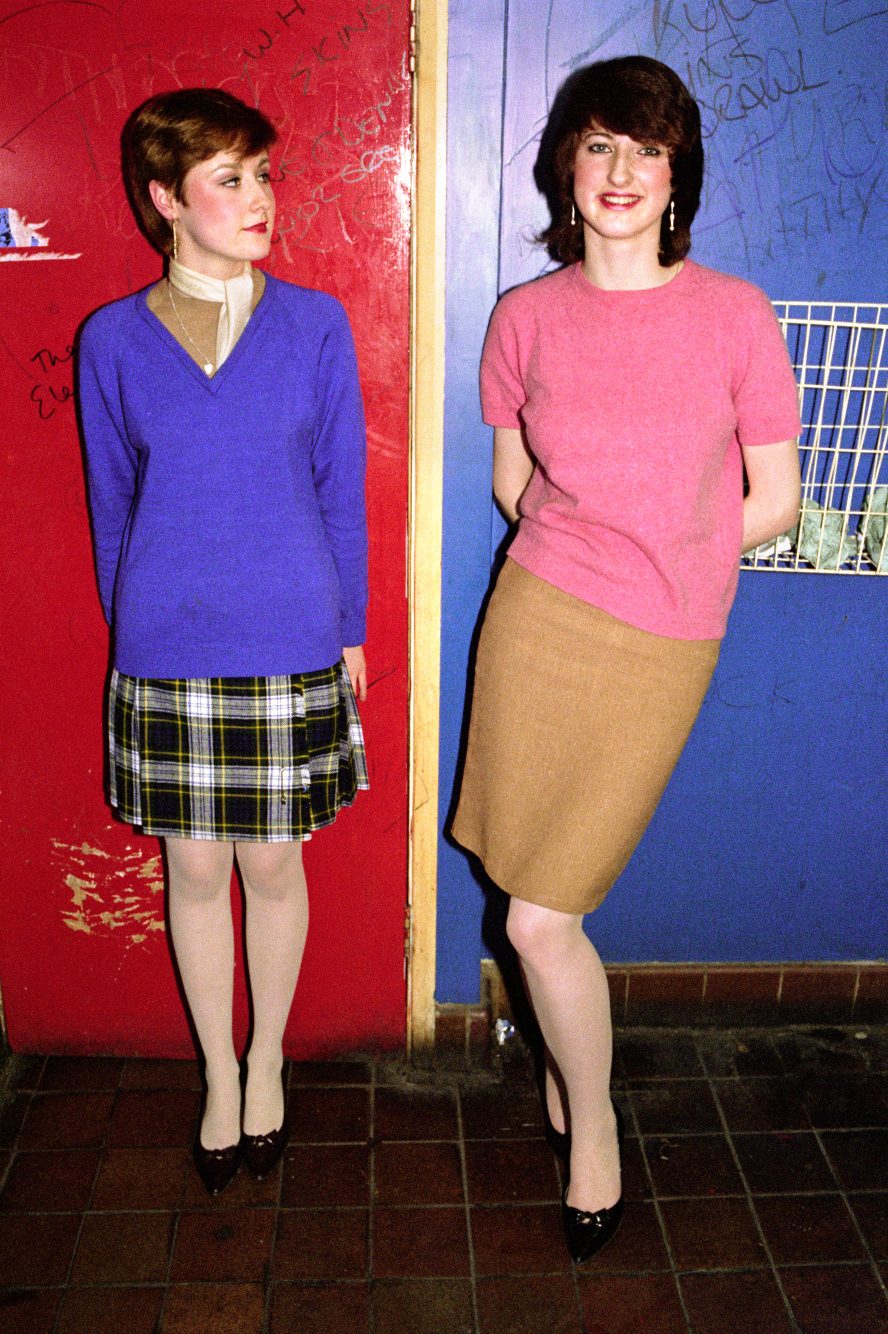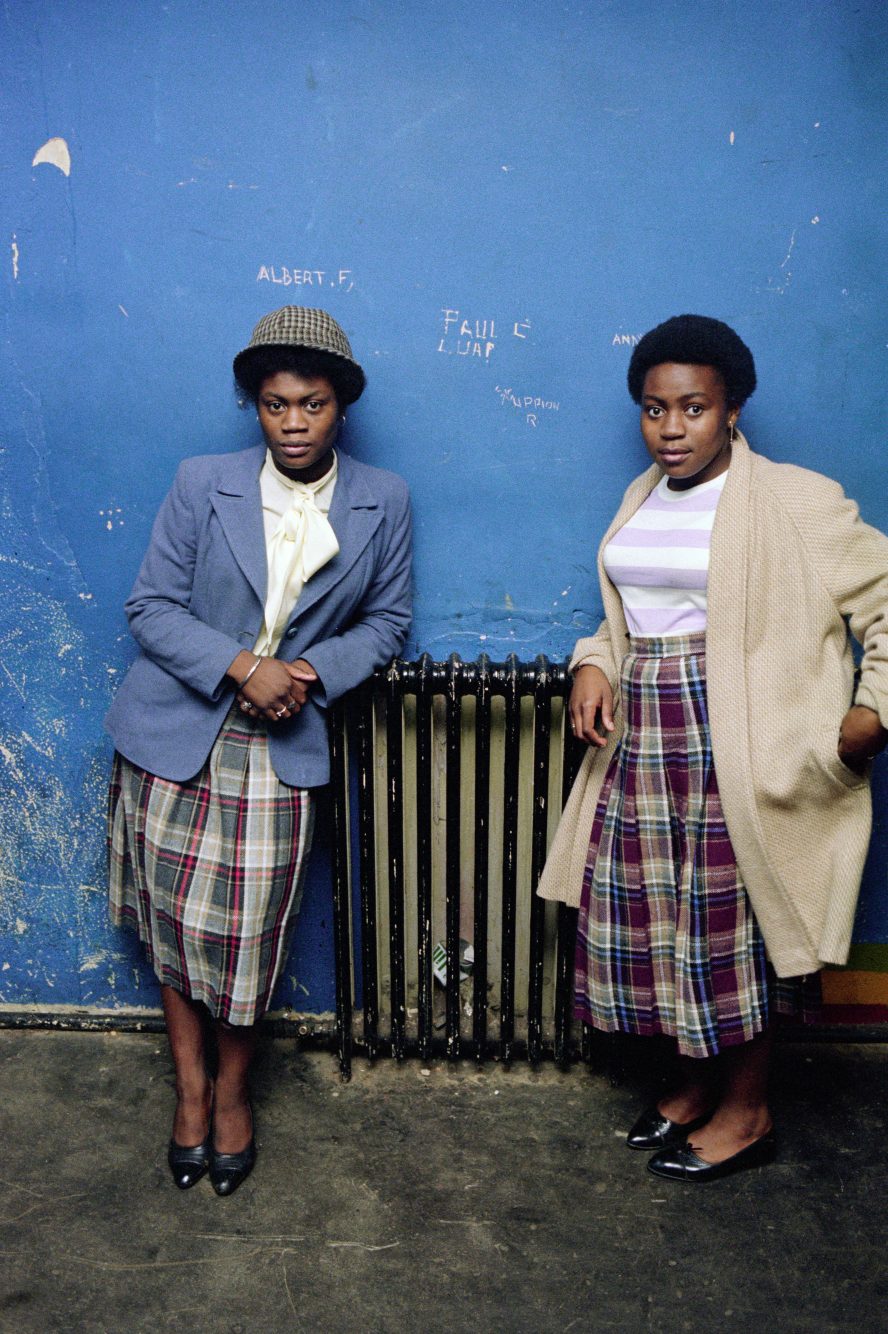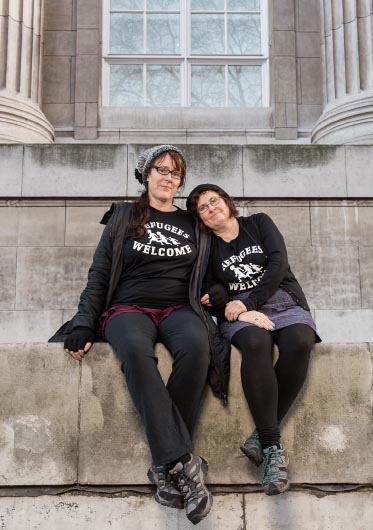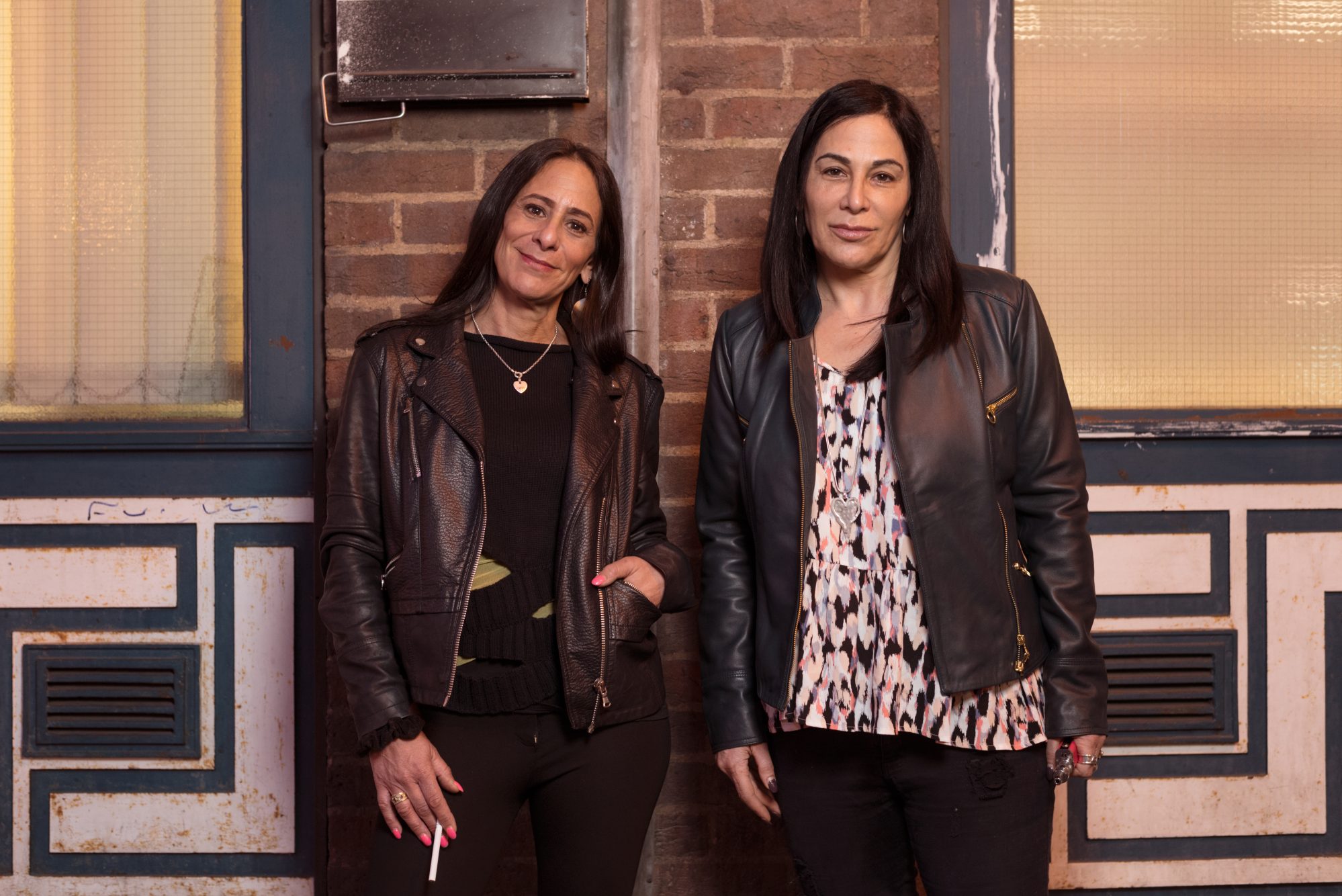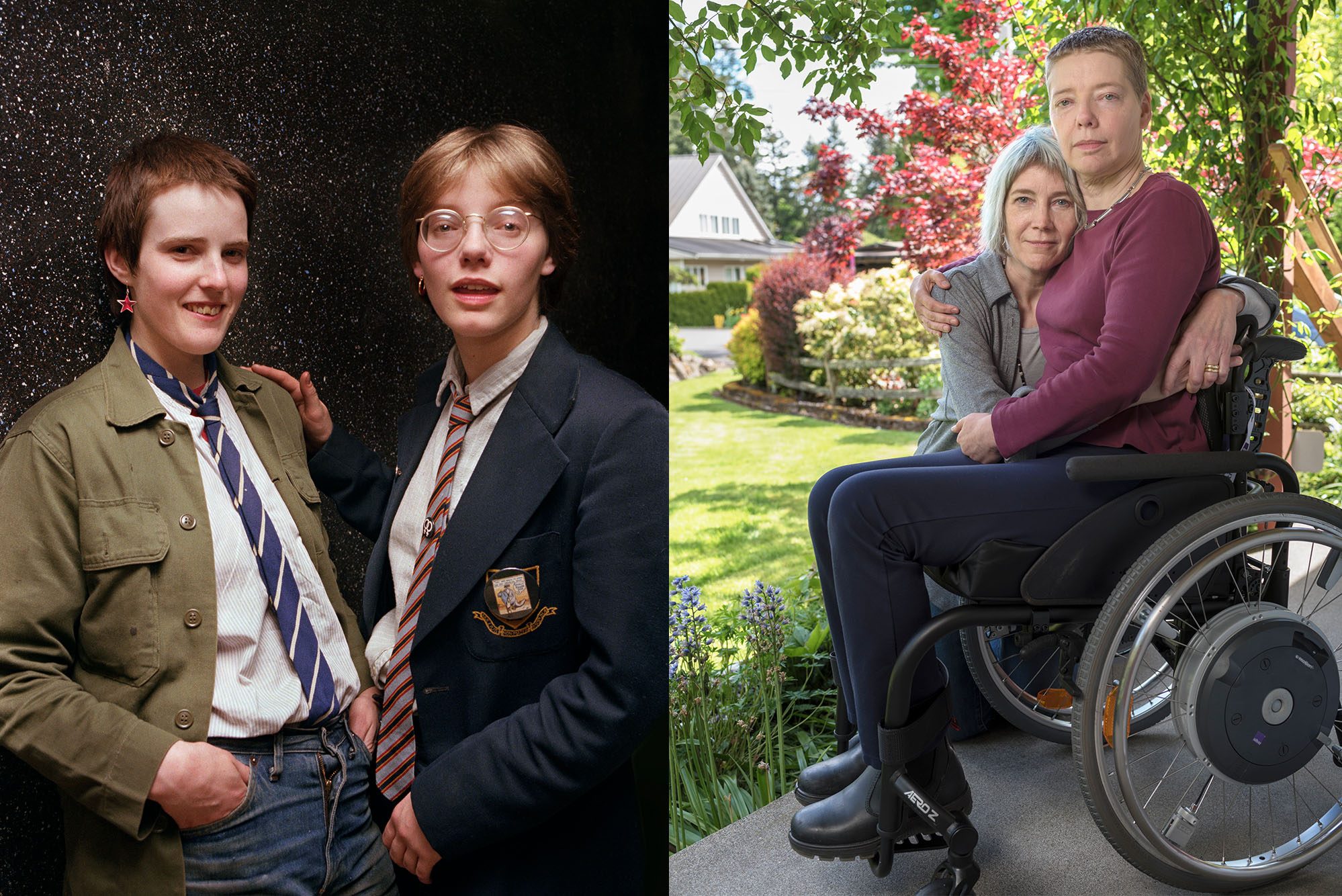The Missing Girls
This is a growing exhibition! The search continues for those original Visible Girls as yet unfound. Their portraits will inform the walls and the next phases of the show.
If you are a Visible Girl reading this – or think you know a Visible Girl please get in touch by emailing us.
Stories: LIZ & JAN
click on the portrait to reveal the old and new portraits

Liz Remembers…
‘For us at that time there was a sense of rebellion,
about not doing it the way our parents did it...
I was determined that my life would not be like my mum’s.’
‘You know, I didn’t really consider myself to be part of a subculture. We were just quirky people who were later named, ‘New Romantics.’ During the day, we worked or went to school. We were normal. We were only ‘alternative’ in the evenings when we dressed up and went to the Blitz Club.
I made most of my own clothes. For Saturday night, I would go to the market and get a metre of fabric for 25p and knock something up that afternoon. The start of the evening would almost always be at Jan’s [pictured right] house; sometimes six of us getting ready in this tiny council flat. Her poor mother! Putting on makeup, practicing dance moves, swapping clothes and jewellery and stuff and getting ready for the night. Then there was the thrill of, ‘would you get in? Would you be cool enough?’ Steve Strange [1980’s singer, club host and promoter] stood on the Blitz door, eyed you up and down and decided whether you were worthy to be let in. It was a bit crass really, and looking back I can’t believe I submitted myself to this bloke’s scrutiny!
I worried about nothing from the age of seventeen to my late twenties except getting through the door of the Blitz. I was confident I would get a job I would enjoy, I didn’t think about the housing ladder, we just partied, you know? We were living in the moment. Yes, we were incredibly image conscious but we were certainly not size zeros and it didn’t matter. We made the best of what we had, never worrying about being taller, thinner or having bigger boobs. I didn’t have a bulging wardrobe either. We all grew up in a time where you wore what you were given and it was hand-me-down. There was no pressure at school to have certain brands or whatever, so I feel I was really lucky because now there’s pressure on youth all the time. How you look is the first thing my young nieces comment on. They don’t go anywhere without a full face of make up and I don’t think it’s healthy. A lot of young people get stressed about it; they become ill they get anorexic, depressed, it’s awful. Wanting to see a plastic surgeon is commonplace.
I am 57 now. And ‘not letting yourself go’ is a phrase I have been hearing more over the last few years, which is quite troubling - as if women over 40 are a bunch of flowers that are going to go to seed. We are expected to stay young, not to age gracefully. We are told to resist, die our hair and wear bras that defy gravity.
When I was in my 20s there was also a sense of rebellion, about not doing it the way our parents did it. Forging our own brave new world. I was determined my life would not be like my mum’s and there was a feeling of possibility that the world was out there waiting to be taken. Old-fashioned notions of what a girl could or couldn’t do were out of the window.
When I hit my 20s, I also joined the ‘activists’ subculture and I am still a part of that today. I spent a lot of the 1980s marching: Greenham, CND marches, anti-apartheid, poll tax, Section 28, Reclaim the Night - you name it, I was there. Any sort of injustice spurs me on.
Post-Thatcher, there was much less to fight against - plus there were more young people in higher education and buying their own houses, so they had more to lose and didn’t want to rock the boat. In recent years, some of that rebellious youth spirit seems to have returned. More and more young people are getting involved in politics, the Labour party, climate activism. It’s exciting to see them doing a bit more ‘boat rocking’ again.
Now, I’d describe my tribe as: ‘Families fighting for rights for their disabled children.’ My subculture is what I do. My activism has become very focused because as you get older you realise that there isn’t enough time to do it all. It’s different to when you are in your teens. You want to take on everything.’
Anita Remembers…
The original portrait is called, ‘Jil And Friend’ because the music that night in the Blitz Club was so loud that I had no idea what the girl on the right was called! It was taken in the gents toilets at 3 am; I remember thinking when I saw these girls - ‘they look incredible!’ They were wearing really unusual outfits; dresses that had a hand-crafted look. You could see the effort they had put in to their ensembles. They were very cutting edge. In later years, their look would be named ‘New Romantic’ but back then they were referred to as ‘Peacocks’ or ‘Blitz Kids’. It was a cross-over look that was flamboyant and androgynous - men could dress as women and vice versa.
Style was your passport to the cool clubs like the Blitz and you would looked up and down by Steve Strange - who was the Blitz door style-monitor. If you got let in, that was validation of your style status. I remember getting the look from Steve as well. That Tuesday night, I was probably in my usual bomber jacket and some crazy colourful outfit. The Blitz really was a mecca - it was all about costume, freedom, creativity - it was sweaty and smoky and full of throbbing beats; total heaven for young people.
Jan (right) was very excited about being photographed - Liz was slightly more reticent. They were both dancing about to David Bowie when I got the shot - they were huge Bowie fans.
Incidentally, despite being very popular with a lot of visitors to the exhibition, this image very nearly didn’t happen at all! I took it at the end of the night and so I had virtually no battery left. Plus, there was a technical problem and the image developed badly - but I just about managed to print it and Metro [printers for the VGR show], of course, did a brilliant job retouching it for the Revisited show in 2017.
Liz (now an activist) and Jan (who now works in the law courts) are both in their fifties. They were discovered at the very first Visible Girls: Revisited show in Hull. One of the venue volunteers was looking at the images during install and recognised his wife, Liz! (read the full story here http://visiblegirls.com/hull/) Liz, it turned out, still had details for Jan, despite not having had contact with her since 1985. The new portrait reunited them 36 years after the last time they had seen each other.
As for the venue for the new shot, the fabulous Blitz Club was no more. It had been converted from a no-holds barred, super fashionable night spot for freedom and gender fluidity… to a stereotypical no-females, ‘gentleman’s club’ - complete with pole dancing! At the reshoot, Liz remarked, ‘the only way I’d be photographed there would be outside with a placard!’ And so we set the new shot up, just before Christmas at a nearby hotel lobby - a lobby that was so narrow I had to work standing in the open lift navigating hoards of people coming and going for the festive season.
In the original image, Jan, was in black and Liz was in white. For the Revisited portrait, I asked them to swap outfit colour schemes. They also exchanged the half pints they would have been drinking back in the 80s for more grown-up cocktails.
Their gestures are reminiscent of the original portrait but imbued with the spirit of who they are now: grown women looking into the camera, facing the world and saying we are proud of who we have become.
A lovely side note: I rephotographed Liz and Jan and Claire and Lisa on the same day, and so afterwards we all got together for a drink.
By a bizarre coincidence, Liz the New Romantic (pictured left at the Blitz Club) and Claire the ‘Nutty Girl’ (pictured left outside the British Museum)
realised that they both live in the same small village in Yorkshire. They have since become friends and attended the VG:R Norwich show together!
Stories: Claire & LISA
click on the portrait to reveal the old and new portraits
CLAIRE REMEMBERS……
‘You have to play by the rules as you get older’
When this photograph was taken, we were on a school history trip from Scotland to London. Our look was ‘rude girl’ and developed out of what we saw the band wearing when we went to gigs. Gigs were a rarity in Scotland back then, but Madness played Dunfermline in 1980. We were 14 and had to plead with our parents to let us go because it was in a nightclub. My dad came with us, went to the front of the queue and said, ‘don’t give those girls alcohol!’
Ska music came and blew everything else out of the water - punk was quite stale by this time and Madness were so fresh. When you look at the early pictures of them, they were just so cool and the music was like nothing I had ever heard before.
On that particular trip to London, we looked up Chris [Foreman, Madness guitarist] in the phone book. He lived in a council flat in Chalk Farm and we just went there! You could do that back then. Three times a year we would go down to London and hang out with the band and go to the studio and make tea. If they came to Scotland we just followed them on the tour, got drunk and slept on hotel room floors. Not groupie-ish; just good fun.
In the mid-1990s I became a road protester and there is a certainly a tribe ‘look’. At its most extreme it was leggings, dreadlocks, piercings, baggy jumper, a bit grungy. I’d wear about 13 layers, all second-hand: leg warmers and derry boots, maybe a bindhi…then a wax jacket. Plus, looking like that, men would hassle you less which was good if you couldn’t be bothered to tell them to bugger off. The more hippyish I got, the more they left me alone. We all wore carabiners too, so you could lock yourself to whatever the authorities were intending to demolish and the police would have to drill you out of it.
By my late 20s, I was a full time activist. I still do it and it is a big part of my identity and belief system - along with community. I think of myself as being more rebellious now than I was then. But you have to play by the rules as you get older to a certain extent - especially if you have a kid. Otherwise you’d be homeless
- society want to know. If you don’t conform, people don’t know where to put you.
‘Why haven’t you got a car, why haven’t you got a mortgage?’
There are a messages that are being subtly and not so subtly conveyed about what is acceptable behaviour for women of a certain age: young women should wear this, older women should wear that, you should be like this. It’s nonsense; you should just do what you want. You have to not give a shit what others think but people fear being excluded by being different I suppose; the loneliness, being ridiculed…people are worried about that.
And so they conform.
And that thing about women being visible or invisible: my question is ‘invisible to whom?’ Do you mean to men? Because that’s what it’s about isn’t it? Because for sure, nobody is invisible to me. So this thing about ‘visibility’… it’s all about that desirability to remain under 30 isn’t it? Because that’s what men want.
My tribe now? Scottish, middle-aged, vegan activist…living in Yorkshire… Not a very catchy tribe and I don’t think there are many members! However, the vegan community is massive these days. I was vegan way back when it was quite radical. Yes, we were the trailblazers back when the only thing on offer was crap soya milk.
And now its gone mad!
Anita Remembers…
Visible Girls
It was 1981 and I was on Mallet Street in London, just after some women’s conference near University College. I saw these four girls walking towards me, all dressed alike in loafers, ‘Nutty Boy’ T-shirts [indicating Madness fans] and Harrington jackets. There were a refreshing change after a morning listening to heady, radical feminist theory! They had a transistor radio with them and were basically dancing their Madness moves in the street wherever they felt like it. It turns out they had just escaped a school trip to the British Museum.
To me they embodied fun; for them, life was good and simple and there was nothing else to do but hang out with their tribe.
Obviously to me they made the perfect Visible Girls portrait. In the original, the two girls were Claire (right) and Sarah (left) who climbed fearlessly up on to the wall of the British Museum.
I loved the contrast: the two girls, full of life, rebellious, young and free, scaling the museum which stood for the opposite: institutionalism and greyness, covered in pigeon shit with the bars up at the windows which you can see above them in the original image. I was using a strong direct flash on a shady side of the building and the resulting strong shadow-mark almost lifts the girls off the wall in a very dynamic way - another contrast to the fixed solid, immovability of the museum.
When the shout went out on Buzzfeed for the Visible Girls to come forward, it was Claire who emailed me. She had lost touch with Sarah since the photograph was taken, but she was still in contact with Lisa, one of those original four girls dancing down Mallet Street, and so it was Lisa who clambered up on that same wall with Claire thirty-six years later.
Revisited
It took a long time to coordinate the Revisited portrait on a freezing December day in 2017. But I did manage to reshoot the image in exactly the same location as the original picture, which - as I have discovered since beginning this project - isn’t alway possible!
The British Museum was doing building work that day, so there were lots of security guards about. In stark contrast to the 1980s shot, in which we just clambered all over the Museum at will, my older, more sensible self went to the guard, politely showed him the picture and diplomatically talked him into letting us get up on the wall!
We had 30 minutes to get the shot. The weather was terribly cold, with wind buffeting the flash stand. But it was quite a moment when, 36 years on from that original day, Claire sat on that very same wall, taking her place this time on the left and Lisa on the right.
Back then, they had been wearing Madness T-shirts because Madness were the centre of their world.
For the reshoot, I wanted them to once again be wearing T-shirts that showed what mattered most to them. Claire decided that the refugee message was right for these times.
Despite the exact same location, there is a key difference in the new image: both women’s eyes are now visible and they are looking at the camera. I wanted all of the women in the Revisited portraits to be looking back at me as much as possible. I wanted this to be symbolic of how all these women have grown into themselves, developing grit and strength and confidence. Acknowledging that they have aged, and owning that 100%.
Stories: LINDA & SUSAN
click on the portrait to reveal the old and new portraits
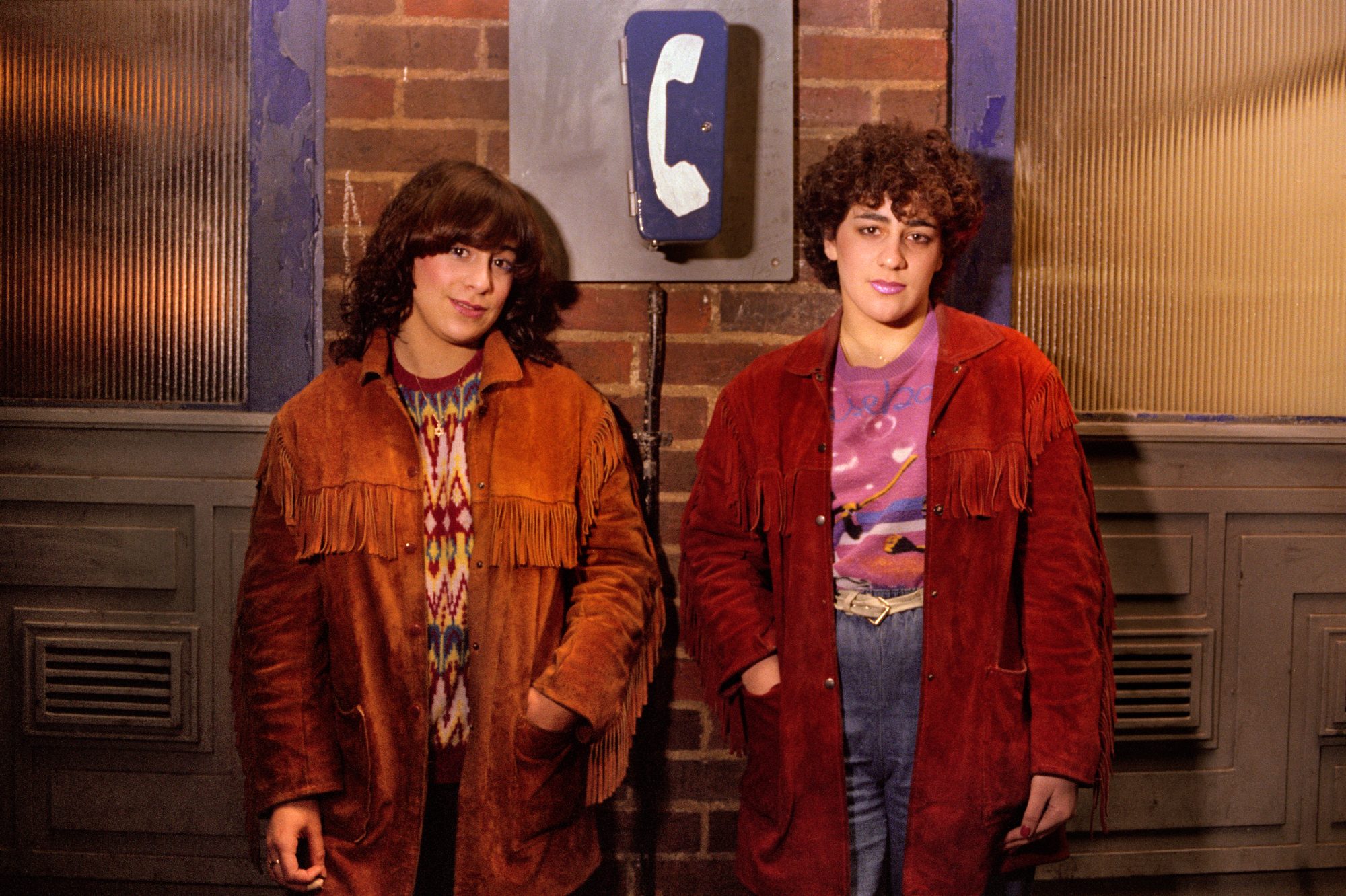
LINDA
‘I remember this photograph being taken but I only saw it for the first time over 30 years later when it was on Facebook. I was hysterical with laughter. I had to call Susan. We were like – ‘OH GOD HOW AWFUL WE LOOK!’ My kids were wondering what on earth I was shrieking on the ‘phone about at 7am.
‘In my teens, I loved having my photo taken. Southgate station had a photo booth so we would all crowd in there. I had an Instamatic – I was always at Boots getting pictures developed. If I took a photograph that I didn’t like I ripped it up and no one would ever see it, but it’s different now for my four daughters. I can see the stress they go through, looking at images of themselves on social media – worrying they don’t look good. If someone takes a photograph of you now, it’s out there forever.
‘We are Jewish so that was our scene. In our early teens we would hang out at McDonald’s, the Baskin Robbins in Golders Green, we would go to pubs – not drinking but hanging around outside. We’d go to Hampstead and meet at The Milk Churn for a salad or ice cream and hang out there all night; to meet new people – but boys mainly.
‘In our twenties we would go to the Camden Palais where all the new romantics were. I remember feeling quite inferior because they had made such a statement with their clothes and make up. I remember the skins, the punks, the fights…The Royalty would see massive clashes between the skinheads and the blacks.
‘I didn’t have any statement to make like the subcultures did. My dream wasn’t to rebel but to be financially secure and not have to be reliant on a man. I got a job as a John Lewis fashion buyer at 16 and bought my first flat at 22. I always regret not travelling though.
‘In my thirties I was more confident. I was still friends with many of the people I had known in my twenties but we were now all married with kids and we’d all do things together with our families.
‘In my fifties, I still feel confident. If I didn’t ‘fit’ now, it wouldn’t bother me, whereas when I was 13 the group could be very bitchy if you didn’t fit in with the ones we called the ‘Becky Jews’. Being in your fifties doesn’t mean ‘old’ any more. I wear similar clothes to my kids – boots with a heel, black jeans… As opposed to my parents generation. My mother would never have worn jeans. I also don’t perceive there to be subcultures now. If someone has pink hair – so what? We would never say, ‘ooh they’re making a statement there!’
‘If young people want to say something nowadays they just say it. They don’t need to be in a group to express it. Maybe they don’t have things to fight for…if they want something, society says: ‘go and get it. You can have whatever you want. You can be whoever you choose.’’
SUSAN
‘My sister Linda and me weren’t part of a subculture really. I was 16 then – too young then to be aware of what subcultures were. But we wouldn’t have been scared of a punk or crossed the street if we saw a group of them. I don’t remember ever being frightened or feeling intimidated by going up to London. I don’t think we were scared of very much really. The world seemed a less scary place back then – either that or it was the courage of youth!
‘There were quite a lot of us in our social group, but I was still young and hadn’t yet found out who I was and I liked all different sorts of things. It was probably just the start of ‘going out’ for me.
‘We wore whatever was in fashion really – I think the sweatshirt I’m wearing was from Miss Selfridge but we also shopped at local boutiques. Going by what I am wearing in this picture, I wasn’t properly clubbing by then – it would certainly have been something better than that horrible jacket!
‘On a night out, we would have friends round at mine and gather there, or round at friends’ houses. We are Jewish and there were clubs and events put on especially for the London Jewish teenage scene and we used to go to those wherever they were. At that age, we weren’t drinking really – but if we did it was probably something like Malibu or Cinzano – but most of the time the clubs we went to were put on for teens so there wasn’t alcohol there.
‘We rang people to organise a night out. No mobile ‘phones, it was all by house telephone. We would arrange to meet at a certain place
and…well, you just got yourself there, didn’t you? It’s bizarre thinking about it now. Having no mobile ‘phones, you couldn’t be like ‘where are you? Are you late?’ Nope, you just had to wait for people to arrive.
‘A lot of the clubs would be playing disco but I also liked Spandau Ballet, Adam and the Ants, Heaven 17, David Bowie… so it was the start of, I suppose, the new romantic stuff. I had my own stereo with cassette and record player and lots of 12-inch singles.
‘I think music has much less of an influence on fashion as it once did. Back then, you could tell by the way someone dressed what movement they were part of, but now there doesn’t seem to be that divide. Now it’s the ‘age of celebrity’, and that’s what influences us. I think teenagers today aspire to look how a certain celebrity looks. They don’t dress to be associated with something or a type of music or scene.’

Anita Remembers...
‘Early evening on Saturday 28th March 1981, I was headed to The Royalty Club to photograph some rockabillies. As I exited the tube at Southgate, I spotted these two girls hanging around the photo booth. I knew immediately that I wanted to capture them as part of Visible Girls and they turned out to be sisters, Linda (aged 15) and Susan (aged 17).
They weren’t obviously aligned to a subculture, but as a pair of North London Jewish girls out on a Saturday night in their almost matching suede, tasselled jackets they were an important part of the scene for me to capture too. I was very focused on showing the lives of as many young women as possible, as a way of saying ‘here we are’! I didn’t know until 36 years later where they were even headed that night!
‘I took six pictures in total on my Olympus OM 2 and I was probably only with them for five or ten minutes. I only had a budget of two rolls of film per night (72 frames) so I knew I needed the rest for the shots of rockers in the club I would be taking later.
‘36 years on, I met the sisters again. Linda (now 51 with four daughters, a puppy, a husband and a full time job) had got in touch with me just before Christmas 2016. She had seen the original images on Facebook. Both her and Susan (now 53, an avid traveller with a fast-paced sales job),were up for being photographed for the Visible Girls:Revisited project. To my delight, Southgate tube station looked more or less the same – even the telephone was still on the wall!
‘This time I had a lot more equipment, including a heavy-duty tripod and a light on a stand. In 1981 it was just a camera bag and portable flash, as I had to be nimble on my feet, jumping on and off tubes and buses en route to shoots.
‘This time around, Susan and Linda stood posing for over an hour and I took over 200 pictures on my digital Nikon D750. Typical of the modern age, we also had to deal with several photo-bombing moments; the most notable being a young guy straight out of the gym (a gym that just so happened to be where The Royalty Club once stood) who whipped his top off and asked for permission to flex! Not a bad end to the night for three fifty-something women…’
Stories: CAROL & NICOLA
click on the portrait to reveal the old and new portraits
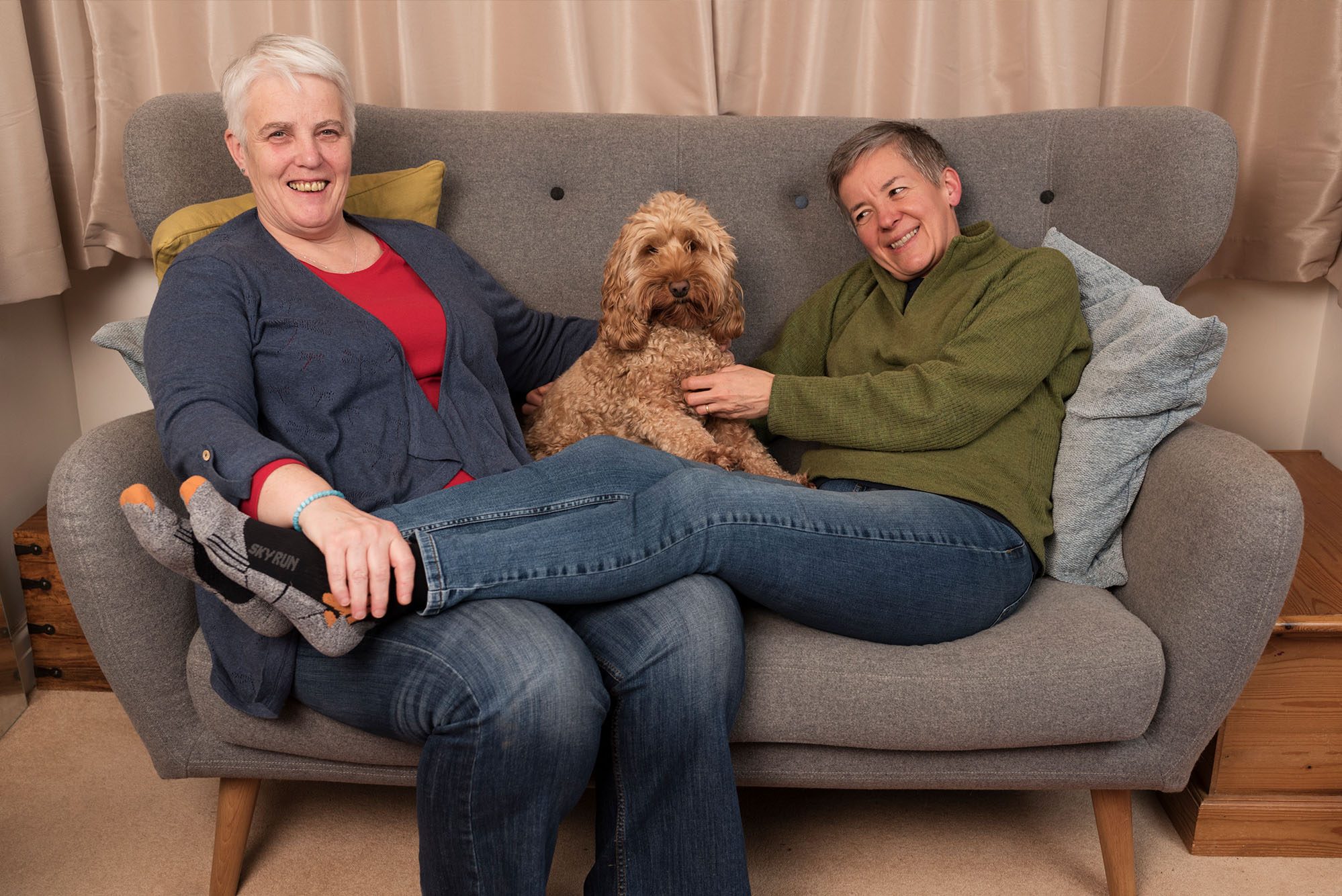
CAROL
‘That day the photograph was taken we were at a disco after attending the first National Lesbian Conference in London. It was exciting – there was such a sense of solidarity. It was important to show people that lesbians weren’t just a ‘little group’.
Growing up, I knew there was something inside me that I really needed to understand but I wasn’t sure what. I knew that I needed to get away from small town expectations: working in the local factory, getting married – and having Christ knows how many kids. I wouldn’t call what I was doing rebellious.It was I think, desperation.
‘My subculture gave me a hook to hang my coat on for a while. It provided a sense of family but in hindsight it wasn’t truly me. The real me was that small town girl, and all of a sudden I’d met all these clever, student Feminist lesbians. I was very working class and they used language I only pretended to understand.
‘But it was through that subculture that I realised, ‘oh, I’m a lesbian!’ and it was important for me to have found that tribe. That particular subculture allowed one, true part of me to flourish but it wasn’t always in alignment with the other parts of me. People are more complex than
their communities.
‘I think that’s why I’m still growing into myself, still trying to find out who it is that I am. And subcultures, those groups… it’s very easy to fall into them purely for that sense of belonging that
we all want. ‘There was a lot more discrimination back in those days. Lesbians were abused by people in the street. A neighbour put a burning magazine through our postbox once when we lived in a lesbian shared house. Subcultures make it easier for people to discriminate against you because they can then de-personalise you. People can act out dislike on a group. Whereas, if they know you as an individual, they have to question their own morals. Of course, you are providing yourself with some safety by attaching to a group but you are also making yourself a bigger target.
‘I was happy to be part of the subculture on the community rather than national level. On a community level in Hull we did a lot of things.We set up the first women’s centre and Rape Crisis line. That was a big thing at the time. Now, I realise I can’t change the bigger things. I can only live the way I think is a good way to live and hope that will influence other things, other people. It’s still change I think but on a much quieter scale.’
NICOLA
‘All I remember about that photograph was that I was trying to protect Carol, because about two minutes before she’d been freaking out a bit.
We’d been taking magic mushrooms, you know how it goes. Anita came up and said, ‘Hey, can I take your picture?’ and I turned round to say, ‘No!’ but Carol beamed and went, ‘Yeah!’
‘If I identified with a tribe then I’d say it was ‘Lesbian Feminist’. We did have some signs and signals: the haircut, the women’s sign badges, ties and braces and I wore them because I liked what they stood for, equality. But I also wore them because if you were in the supermarket and you saw someone else wearing that double women’s sign you’d think, ‘Thank god, I’m not the only one. Not everyone in the room will turn on the dyke and spit’.
‘As we get older we become more ourselves, individuals, and that makes us less tribal – less willing to just go along with things – more likely to ask questions. When I was 19 I hadn’t learnt the rules of the tribe and just said stuff. I wasn’t very popular. After a year or so I learnt to keep my mouth shut because asking questions was ‘Not Done’. But the thing I most disliked about the Lesbian Feminist ethos was The Collective: not just that we were equal but that we all had do exactly the same thing, no matter what your particular skills. Everything together all the time. It drove me crazy – it was ridiculous and just wasteful.
‘Since then, I’ve belonged to many tribes. I’m still part of the queer community here in the US, and different writers’ communities – science fiction, crip fiction, historical fiction. I’m doing research, and a PhD, so I also mix with historians and academics. There’s my neighbourhood community, the online crip community… I’m part of many subcultures now but don’t wholly belong to any.
‘Subcultural membership then and now is different. Back then, being part of the Lesbian Feminist tribe was critical to survival. Without that kind of support, well, it was dangerous. Police harassment, rape threats, arson. I was beaten and hospitalised. We kept each other sane, and found joy instead of living in terror all the time. Now, thanks to social media, you can find your people more easily. Sometimes its not just need but more of an affinity group. You can be a left-handed, blue-haired, dog owner and there will be a group for you. The downside of online communities is that they don’t bring you food when you’re sick, they won’t help paint your house, they can’t hold your hand while you grieve for your mother or a sister who died.
‘I also think it’s absolutely true that as a woman you become invisible as you age. The minute you look infertile you stop being a sexual object and prey. To men particularly you are no longer noticeable. That’s so not a problem for me! And in some ways I’m now in my fifties more visible than ever. I’m an Englishwoman in the US and I’m in a wheelchair. I’m an author who goes on tour: when a new book’s out I’m on the radio, in the paper, on TV. I get recognised, sometimes when I don’t want to be. But then there are those times when I’m not seen and I’m like – ‘Hey, why is everyone ignoring me?!’
This error message is only visible to WordPress admins
Error: Connected account for the user visible_girls does not have permission to use this feed type.



